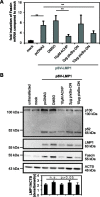The tumor marker Fascin is induced by the Epstein-Barr virus-encoded oncoprotein LMP1 via NF-κB in lymphocytes and contributes to their invasive migration
- PMID: 25105941
- PMCID: PMC4222691
- DOI: 10.1186/s12964-014-0046-x
The tumor marker Fascin is induced by the Epstein-Barr virus-encoded oncoprotein LMP1 via NF-κB in lymphocytes and contributes to their invasive migration
Abstract
Background: The actin-bundling protein Fascin (FSCN1) is a tumor marker that is highly expressed in numerous types of cancer including lymphomas and is important for migration and metastasis of tumor cells. Fascin has also been detected in B lymphocytes that are freshly-infected with Epstein-Barr virus (EBV), however, both the inducers and the mechanisms of Fascin upregulation are still unclear.
Results: Here we show that the EBV-encoded oncoprotein latent membrane protein 1 (LMP1), a potent regulator of cellular signaling and transformation, is sufficient to induce both Fascin mRNA and protein in lymphocytes. Fascin expression is mainly regulated by LMP1 via the C-terminal activation region 2 (CTAR2). Block of canonical NF-κB signaling using a chemical inhibitor of IκB kinase β (IKKβ) or cotransfection of a dominant-negative inhibitor of IκBα (NFKBIA) reduced not only expression of p100, a classical target of the canonical NF-κB-pathway, but also LMP1-induced Fascin expression. Furthermore, chemical inhibition of IKKβ reduced both Fascin mRNA and protein levels in EBV-transformed lymphoblastoid cell lines, indicating that canonical NF-κB signaling is required for LMP1-mediated regulation of Fascin both in transfected and transformed lymphocytes. Beyond that, chemical inhibition of IKKβ significantly reduced invasive migration of EBV-transformed lymphoblastoid cells through extracellular matrix. Transient transfection experiments revealed that Fascin contributed to LMP1-mediated enhancement of invasive migration through extracellular matrix. While LMP1 enhanced the number of invaded cells, functional knockdown of Fascin by two different small hairpin RNAs resulted in significant reduction of invaded, non-attached cells.
Conclusions: Thus, our data show that LMP1-mediated upregulation of Fascin depends on NF-κB and both NF-κB and Fascin contribute to invasive migration of LMP1-expressing lymphocytes.
Figures






References
-
- Baichwal VR, Sugden B. Transformation of Balb 3T3 cells by the BNLF-1 gene of Epstein-Barr virus. Oncogene. 1988;2:461–467. - PubMed
Publication types
MeSH terms
Substances
LinkOut - more resources
Full Text Sources
Other Literature Sources
Research Materials
Miscellaneous

